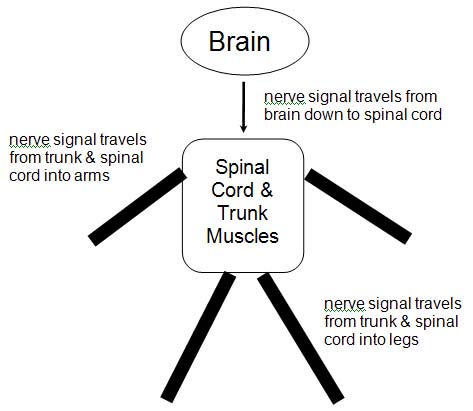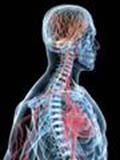
Please wait up to 10 seconds for the video to load. Click on the video once it starts playing to pause.
Step 2: Plan To Lose Fat Faster and Faster!
We discussed in the last post that the key to accelerating fat loss is by specifically raising the # of METs with a given activity by using more bodyparts at once. However, the limiting factor to doing so is the ability to send direct and targeted signals to every muscle you want while resting the other ones. ‘Muscle Coordination,’ if you will...
You’ll also need to improve ‘Muscle Timing,’ meaning the sequence your muscles fire to protect a joint with any given movement. For example, when you do an upright row, do you contract your lats first or your biceps?
As it turns out, it’s much better on your shoulders if you learn to contract your lats first. When you decrease pain signal to joints by firing muscles in the right sequence, you speed up the signal to your muscle even more. A faster, stronger signal = more muscle involved.
There Are 2 Ways To Stimulate Muscle And Increase Your Metabolism, Not Just One.
One idea would be to work as many muscles within a given workout as you can; another possibility would be to enhance the electrical signal to a group of muscles, instead. Now, by working on nerve instead of a muscle, you are actually working on multiple muscles at once, and, more importantly, all of each muscle.
The Truth: Your Nervous System
Controls Your Muscles.

 Every nerve signal starts at your brain and spinal cord, or your CNS. After a nerve signal comes down from
your brain, it goes through your spinal cord and exits from your vertebrae.
Every nerve signal starts at your brain and spinal cord, or your CNS. After a nerve signal comes down from
your brain, it goes through your spinal cord and exits from your vertebrae.
The average spine has multiple rotations and/or sidebent segments from top to bottom, simply as a result of poor sitting posture, old injuries, and other issues. Every time a segment is rotated or sidebent, it adds slight tension to a nerve that exits from that level.
Consider how your muscles could pull on your vertebrae, for example, and re-align them with a more ‘neutral’ spine position. Since every segment of your spine has a little nerve root coming out that turns into something like your sciatic nerve, decompressing your spine frees the nerve. When you balance nerve tensions, you increase signal strength to every muscle a nerve innervates. In the case of “freeing” your sciatic nerve, for example, you’d be gaining muscle signal to every muscle in the back of your leg.
It stands to argue that you’ll take much more away from every rep of every exercise,
of every set, and of every workout when you stimulate your nerves, first.
But this is just the beginning... there’s a specific sequence of events that I follow to increase signal strength. Here they are:
- Plan a movement.
- Re-align the spine.
- Excite nerves that relax during day.
- Balance joints to take away subsensory pain signals.
- Ask for more electricity.
- Work related segments together, at once, to improve muscle timing.
- Create ‘cardiovascular override.’
Plan a movement. This increases what’s called “pre-motor activation”, which is using the ‘movement planning’ center of your brain. This area is associated with an increase in muscle strength of up to 30% with every rep. In order to fully engage your pre-motor area, which represents 1/2 of the movement center of your brain, you should integrate all 5 senses into planning a movement (can you visualize the movement, feel the air on your skin, the contraction in your muscles, hear the music in the room, etc.?)
Re-align the spine. By balancing out muscles around your spine, you’re automatically freeing nerves at their roots. These nerves are often choking for oxygen while they are compressed, so they ‘hibernate’ to prevent damage.
Excite nerves that relax during the day. Unfortunately, most of our jobs are unnatural. We tend to spend most of our time in a seated position, or performing repetitions of the same movement. This means that we need to work the other side of our body to turn this side off. Basically, when we use an equal and opposite muscle to one that’s been being used all day, we turn off the neurological signal, temporarily, to that muscle and allow it to truly rest (this is referred to in neuroscience as ‘Reciprocal Inhibition.) This way, when we exercise, we control the signal.
Balance joints to take away subsensory pain signals. When our joints are pulled backward, forward, inward, or outward, we have a smart autopilot defense mechanism that goes off. These tiny little nerve cells that control pain start to set off fireworks, letting your brain know not to pull too hard from this position or something could tear. Once you balance out your muscles around your joints, this signal disappears, and you can maximize the potential of each muscle contraction in that area.
Ask for more electricity. This is where diagonal movements come into play. I take this from PNF theory and apply it to fat loss. By working similar muscle groups together, muscle groups that follow the same nerve path and related nerve paths, we create what’s called “physiological overflow.” In other words, our brains receive a message to finish the movement by pulling in all related areas to accomplish what we’ve set out to do. Diagonal movements are key to demanding more electricity from your system.
Work related segments together at once to improve muscle timing. Muscle timing refers to the sequence you recruit muscles for a given movement. For example, when you’re laying on your stomach and raise your whole leg in the air, your body is supposed to recruit muscles in this order:
- Opposite side multifidus (low back muscle)
- Same side multifidus (low back muscle)
- Same side glute max (butt muscle)
- Opposite side glute max (butt muscle)
For a lot of people, this is out of whack. However, I’ve figured out specific exercises that work to restore the muscle timing in regions of your body. Most importantly, is that you learn to work related segments together and your body starts to figure it out.
Finally, create ‘Cardiovascular Override.’ Essentially, you go back to your most primitive systems whenever you take your body beyond its capacity. Since your cardiovascular and nervous systems came first, you can create an override to each one by alternating the purpose of your workout:
- When you work all three energy systems and no longer have any gas in the tank, you increase excitation of your nervous system, producing ‘Cardiovascular Override.’
- When you hit complete neuromuscular fatigue in many areas of your body at once, it’s your heart rate, respiratory rate, and blood pressure that respond first, producing ‘Neurological Override.’
That kind of makes sense, right?
So, when we want to increase electrical signal towards the end of a workout, we can create a highly anaerobic, or oxygen-deprived state in our bodies and force our nervous systems to kick it up a notch. Pretty cool, huh?
In the next post, you’re going to learn all about the phenomenon of “Rebound Fat Loss” (not weight gain.) It’s just as easy to achieve, but you have to take a radically different approach.
Stay tuned for an email with a subject line of:
Rebound Fat Loss (not weight gain) <--- IMPORTANT.
have a great day,
Kareem
P.S. Here’s another gift for you - I’ve got a “superset” for you to do today. You’re learning to add exercises together and save time. This is the beginning of where things get really cool:
Perform all 8 exercises, as follows:
50 seconds per exercise, alternating as needed. You have 10 seconds to rest/transition to the following exercise. This entire workout will take you 8 minutes, and you’re going to feel amazing when it’s over:











